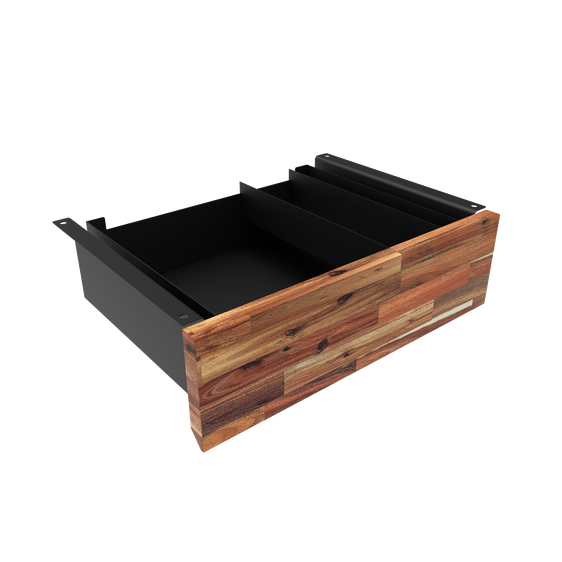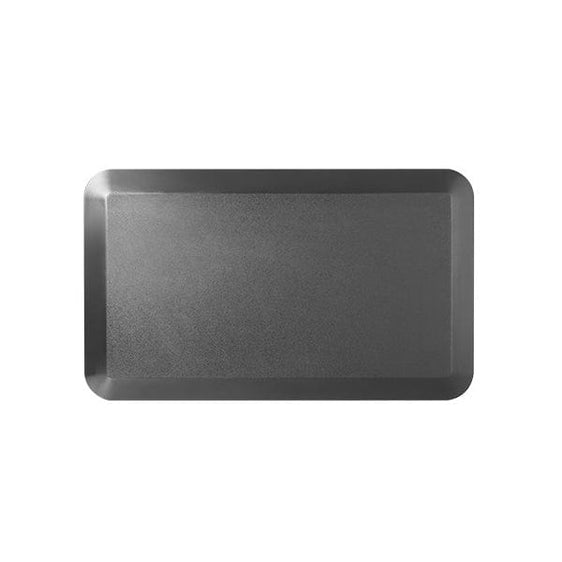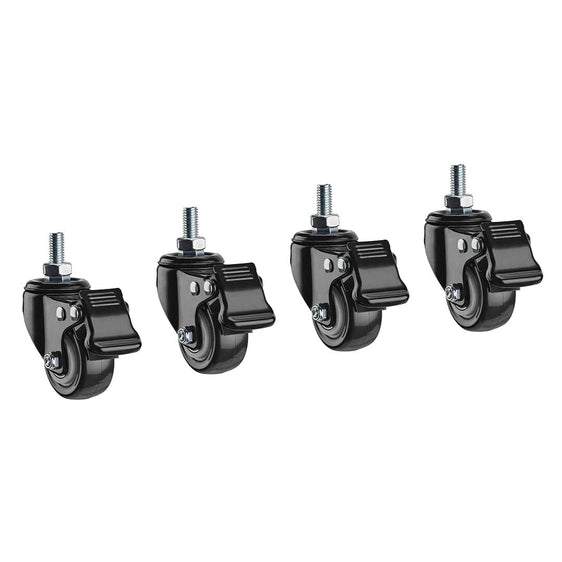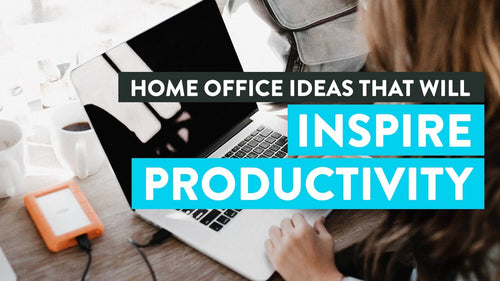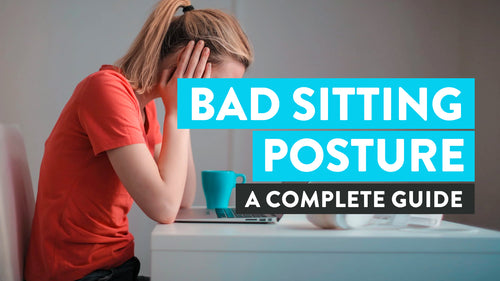
News
The Best Desk Setup For Productivity with 10 Tips for Success
Hayden AdamsFor many of us, the switch to working from home has been a blessing and challenge rolled up in one. While we love the flexibility (hello, PJs as professional attire), we can't deny there are a lot more struggles than we usually encounter while in the office. From kids to pets to social media notifications, there are a lot of distractions vying for our attention at all times. If there are remote work challenges like poor communication or mismanagement, attention can wane even faster. You may find yourself watching the clock creep toward noon and realize you haven't accomplished a thing.
Productivity is an ongoing process. It's all about finding your flow and being "in the zone." People tend to measure productivity in terms of output, but it is so much more than that. Productivity is fluid, and it can be improved anytime by making some changes to your environment. You may be amazed to notice the impact that having a proper work environment has on your ability to stay on task.
In this guide, we'll cover everything you need to create the best desk setup for productivity. We'll start with the basic elements every home office should have; then, we'll dive into the details of desk organisation. Finally, we'll explore how to set up a proper standing desk, ensuring you have a dynamic and ergonomic workspace that supports long-term productivity.
Improve Your Lighting
When you're choosing a spot for your desk setup, aim to be as close to a window as possible. We may spend most of our days in front of a computer, but the human mind and body were built to respond to natural light. Natural light exposure is important for maintaining energy throughout the day, staying motivated and combating depression. Even if you prefer to work after normal business hours, the right lighting plays a huge role in your productivity and reduce eye strain. If you can work by multiple windows, that's even better.

Because you only have a set amount of daylight to work with, you should choose your peak work hours wisely. Even if you are able to break up your schedule, opt to do your most essential tasks when there is ample natural light.
Artificial lighting is equally important. When you're setting up your home office and standing desk, choose the right desk lamp and accent lighting for your line of work. For example, if you make or edit videos or photos, then you'll want a softer light than someone who is analyzing data all day. You may even want to go with an LED desk lamp that has multiple intensity and color temperature settings. This will allow you to adjust your lighting to suit your task and mood.
Add Greenery
You might not think plants are key players in productive desk setup, but they actually have a major benefit. Keeping some plant life around the house boosts your mood, which directly impacts your productivity. Green plants are also natural air purifiers. If you sit inside most days, your home is prone to gathering more dust, dander and dirt than it would if you were out of the house.
In addition to naturally improving your indoor air quality, plants can lower stress, increase energy and leave you feeling more positive overall. You don't have to be a green thumb to keep them healthy, either. There are plenty of low-maintenance plants that have a big impact. Check out aloe vera, spider plant, snake plant and, of course, the world's favorite desk plant, succulents. All they need is plenty of natural light and the occasional watering.

Take Breaks
Blood circulation is a critical component of well being, but many of us spend hours at a time hunched in front of a computer with little to no movement. Make sure that you schedule frequent breaks to move your body. You should also incorporate some desk exercises that you can do from your chair or perform at a standing desk.
Speaking of standing desks, you should look for one with an adjustable height. While a stand up desk does promote good posture and greater energy, you likely won't want to be at one for six to 10 hours a day. When you're ready to relax a bit, you can lower the height while keeping your standing desk setup in place.
Routine breaks should be all about movement, so avoid just picking up your phone and scrolling through social media. In fact, the best thing to do is step away from screens entirely. Refresh your eyes, drink some water and, when you can, step outside for a few minutes of fresh air and sunshine.
Standing all day: Myth vs Reality
The timeless adage "Too much of a good thing..." holds true for standing desks as well—and we're not talking about the wheels yet. While it has been proven to counter the negative effects of sitting for prolonged periods, continuous standing invites its own health risks.
Those regularly on their feet for lengthy durations could corroborate this. Hence, moderation is key, and the 20 8 2 rule becomes imperative.
Understanding the 20 8 2 rule
When considering the utilization of a standing desk, it is essential to comprehend the 20 8 2 rule. This rule, put forth by Cornell University's Professor of Ergonomics, Alan Hedge, promotes a balanced working pattern.
For every thirty-minute period, 20 minutes should be reserved for sitting, 8 for standing and the remaining 2 should involve movement. This variation in posture helps combat the pitfalls of sedentary work, making standing desks—with or without wheels—a smart choice.
Keep Your Workspace Clean
Have you ever found yourself dreading going to work because your desk is a mess? For maximum productivity, prioritise organization. It doesn't matter if you have an entire room for your home office or only a desk in the corner of your living room; you can take advantage of as much space as you have. Start with the essentials. Look into a monitor riser to clear some room on your messy desk. This instantly frees up the surface while simultaneously encouraging proper posture while typing.
{{ spec_clamp_on_riser }}
Keep office supplies in baskets, drawer units and any other organisation tools you can find. Research suggests that a messy desk negatively impacts work performance and increases stress. On the other hand, an organised desk brings a greater sense of control. Through personalisation, you can create a space that you take pride in and naturally feel more inspired to work in.
In addition to these tools, consider using a CPU holder to keep your computer tower off the floor and out of the way. This not only helps in maintaining a clean and uncluttered workspace but also protects your CPU from dust and accidental damage.
A clean surface is the most productive desk setup regardless of your personal tastes. You can instantly boost job satisfaction by creating an area that's pleasurable to work in. Spend time keeping your work space clutter free so you can always feel on top of your game.

CPU holder purpose
A CPU holder plays a crucial role in maintaining the longevity of your CPU. It safely secures your CPU just beneath your desktop, removing it from the hazardous floor zone. This protection prevents any accidental impacts or spills that might harm your CPU.
Additionally, a well-ventilated CPU tends to work more efficiently and stay cooler than one positioned on the floor. Official government sites like Energy.gov advise on the importance of adequate computer ventilation, which a CPU holder can facilitate.
Should I put PC tower on the desk or floor?
Keeping your PC tower on the desk instead of the floor offers several major benefits. Not only does it reduce dust build-up, but it also eliminates risks of accidental impact or spillage. Desk placement proves more secure because towers on the floor might be inadvertently kicked or moved.
Necessity of CPU stand
Adding a CPU stand to your workspace helps maintain the cleanliness and functionality of your CPU. CPUs left on the floor tend to accumulate dust and hair, leading to cooling issues caused by a clogged fan.
Furthermore, CPU stands attached under the desktop free your CPU from the dust-ridden environment of the floor, promoting a longer lifespan for your CPU.
How to Organise Your Desk
Now that you know the importance of having a clutter free standing desk surface, it's time to address the best way to go about organisation. Everyone's work space will differ, but there are some general tips to keep in mind at the same time as you work toward the most productive desk setup.
Keep Commonly Used Items Close
Your keyboard and mouse, planner and office supplies should always be within reaching distance. What's most important is to give each of them their proper place so you're never digging through a pile of papers or knocking over coffee mugs in search of something. When everything is in its proper place, you'll naturally fall into a flow that makes you more productive.
The organisation doesn't stop at your physical workspace, either. Part of desk organisation includes keeping your computer's desktop nice and neat so that you have adequate space for your keyboard and mouse. Don't cram dozens of files with random names into one space. Make folders and sub-folders and clearly label everything so you can always find whatever you need.
Don't let incoming papers languish in a messy, permanent stack - ensure they are sorted daily. Having a monitor mount can also help free up precious desk space, not to mention helping to position your laptop screen or monitor at your ideal height.
{{ spec_eco_vertical_mount }}
Store Everything You Don't Need to Work Somewhere Else
Personalisation is nice, but if your standing desk is constantly cluttered with things you don't need, it can become a huge source of stress and distraction. You need a clearly defined system that stops a disorganised desk in its tracks; no more mail, plates, cups or anything else that gets in the way of the best desk setup for productivity.
You have to treat your existing desk setup like your work station, because that's exactly what it is. Your tasks may be performed on a computer, but the attitude, energy and focus you need to get the job done all stems from the environment you're in.

Limit Your Personal Items
We've talked about personalisation as a benefit to desk organisation, but make sure you are conscious about the pieces you choose. This is a place of work, not a playroom, so avoid filling your desk or office with so many trinkets that it becomes cluttered and distracting. Consider your identity at work. What makes you feel the most confident and inspired? These are what you want around you. The best desk setups are clean, open and have a few personal items that lift your spirits without drawing your attention away from work.
Organise Cables
Using cable ties and cable management channels can keep your technology and desk setups organised. At Desky, we make affordable, easy-to-use desk cord organisers that are perfect for home office organization. With less cable clutter, your desk space will be easier to clean as well.
{{ spec_cable_kit }}
Buy a Comfortable Ergonomic Chair
Posture makes a huge difference in productivity, and setting up your ergonomic office chair to be ergonomically correct is an important part of the perfect desk setup at your home office. Before you get there, though, you will have to first find the right desk chair for you.

A good office chair has an adjustable height that allows you to remain sitting straight. A posture effective chair promotes good posture and positions your hands roughly parallel to the mouse and keyboard. There are also ergonomic keyboards that help prevent strain to your wrist or arm muscles.
Avoid any so-called ergonomic chairs that offer no lumbar support. Sitting on a stool or backless chair can cause you to lean forward, putting strain on your neck. Likewise, this posture can also result in shoulder knots and back pain. You should also be able to comfortably cross your legs when sitting.
How to choose a chair for desk
Choosing the right chair requires a combination of factors to be considered. Be mindful of the support it offers - a good chair should support the natural curve of your spine and allow for flexibility in movement. What type of office chair is best can help guide you while choosing.
Check the adjustability features - does it let you modify the seat height, backrest tilt, and armrest positions? Also consider the material and padding – a breathable fabric and adequate cushioning enhance comfort. Lastly, look at whether it's compatible with your desk – a good chair-desk pairing is vital to optimum ergonomics.
{{ spec_pro_plus_chair }}
Here are a few tips for setting up your ergonomic office chair:
- Set the seat height to keep feet flat on the ground. If you can't reach the floor, use a desk footrest.
- Adjust the backrest to provide some space between your knees and the chair. Approximately 2.5 cm is suitable.
- Try different lumbar support settings until you find one that is comfortable for you.
- Keep armrests level; your elbows comfortably rest on them at all times, keeping your arms at your sides rather than reaching forward.
- If your chair has a headrest, make sure that it is straight. Your neck should be balanced above your shoulders rather than extended forward or leaning back.
- If your monitor screen is too low, a monitor arm can be helpful in order to prevent eye strain.
- Laptop users can consider a laptop riser as well as an ergonomic keyboard so your laptop screen will be at the ideal height for you.
Can you use a chair with a standing desk?
As surprising as it may sound, chairs and standing desks are a great team. There's a niche of tall, adjustable office chairs designed specifically for extras height desks.
These chairs not only help you transition smoothly between sitting and standing positions, they also provide you with robust support when you need a sitting break during your workday. Understanding how to use a standing desk correctly can further enhance your productivity. Remember, balance is key to maintaining physical well-being!
Best kind of chair for standing desk
When it comes to ergonomic chairs for standing desks, there's a fine line to walk. You want a chair that is adjustable, given the raised structure of the desk. Chairs that have flexible heights and offer firm support are key.
Ample back support and a comfortable seat are essential ingredients, too, to ensure prolonged sitting doesn't wear your body down. Combining these features results in an ideal chair that enhances the advantages of a standing desk while mitigating the discomfort that can sometimes arise from long periods of standing.
Best chairs for sitting all day at a desk
Constant sitting can take a toll on your body, which makes picking the right chair all the more important. One of the best chairs for sitting all day at a desk is the Desky Pro+ Ergonomic Chair.
This chair is designed to provide optimal support and comfort for your posture, spine, and circulation. It has a synchro-tilt mechanism that allows you to adjust the seat and back angles according to your preference. It also has a breathable mesh back, a fabric seat with a waterfall edge, and a headrest for extra cushioning.
Ensuring you follow the rules of best sitting position for lower back pain can help maintain good posture, especially if you are sitting for extended periods.
{{ spec_classic_foot_rest }}
Stay Hydrated
If there's one thing everyone should always focus on doing throughout the day, it's drinking enough water. Between coffee, tea and energy drinks, you may think you already get enough hydration, but you'd be wrong. Hydration from pure H20 is incomparable; no amount of coffee is going to make up for a lack of water.
Your body needs to be hydrated to feel refreshed and energized; did you know that caffeine actually has a dehydrating effect? Your refills from the coffee pot can actually worsen your hydration levels, so you should aim for no more than two cups of Joe each day. Instead, keep a refillable water bottle by your side. You can even download a hydration app that sends helpful reminders to pause and replenish.

By drinking enough water, you'll find your energy levels more stable, stress lower and productivity improved. Being hydrated can also help prevent fatigue, lower stress and even diminish anxiety. You should always look to your body first when treating psychological symptoms. Many times, our minds are telling us that what we're feeling indicates a deficiency somewhere in the body and can unconsciously decrease our work performance.
Breathe
You might be surprised at how shallow and tense your breathing can become when you're focused on work. Deep breathing is one of the easiest and most powerful ways to reduce stress anytime, anywhere. There are tons of variations you can try, but you don't have to memorize any fancy routine to experience the benefits. Also try these simple neck and shoulder stretches while at your desk to prevent shoulder pain.
Here is a simple deep breathing exercise anyone can do:
- Adjust your posture so your neck is straight.
- Lower your shoulders, noticing any tension and releasing it as you relax the muscles.
- Inhale through your nose, slowly until you have taken as deep of a breath as you can.
- Hold for three to five seconds.
- Exhale slowly through your mouth, making a "wooshing" sound.
- Repeat two to three times whenever you feel stressed.
Through deep breathing exercises, you can reduce stress (which results in increased blood pressure) and stay focused throughout the day more easily. Sometimes, when we are caught up in our own anxieties, we feel it's better to push ourselves hard than step back. While perseverance is an excellent and important tool, it's equally important to take pause and restore your balance.
In addition to giving you a sense of calmness and control, deep breathing has many benefits for your health. Research suggests that deep breathing can slow your heartbeat, lower blood pressure and activate the parasympathetic nervous system.
Keep the Noise Down
Whether it's traffic outside, kids playing or dogs barking, limit your noise pollution as much as possible. Noise distracts your attention and can even increase your stress if you're constantly trying to ignore unpleasant sounds. You should also consider the effect that your favourite music might have on your productivity and ideal workspace.
Some sounds can make you feel energized and inspired, and you can easily zone out for hours while you work to the beat. But other times, music you use to tune out other noises around you can prove equally distracting.
Sometimes, the most effective solution is to put on white noise instead. White noise sounds are available on YouTube for free, and they can be a flat, gentle static, the whir of a fan, the thrum of an airplane engine and many other soft sounds. A 2012 study published in the Journal of Consumer Research found that ambient noise may enhance creative cognition. In other words, white noise might help you become more creative and can play a part in the best desk setup for productivity.
Even if your job doesn't require any sort of artistic expression, minimizing distractions to stay focused can maximize productivity, keep your stress low, and make work more enjoyable.
Setting Up Your Home Office Standing Desk
As you fine-tune the basic elements of your home office and master the art of desk organization, you'll start to notice significant improvements in your focus and efficiency. A well-organized desk, equipped with the right tools and accessories, lays the foundation for a productive work environment.
However, to truly elevate your workspace, it's essential to consider the benefits of a proper standing desk setup. Now, let's explore how to create an optimal standing desk setup that complements your organized and efficient workspace.
How To Prepare For Standing Desk
Creating an effective home office standing desk setup can transform your work-from-home experience. A well-organized, ergonomic workspace not only enhances productivity but also supports your overall well-being. By focusing on the right components and layout, you can minimize distractions and maximize efficiency.
What is the proper standing desk setup?
Creating a proper setup for your standing desk begins with positioning the platform where your computer rests so it aligns with your elbow when standing, much like when you sit.
Keep your forearms parallel to the work surface while typing, and position your monitor at eye level, angled between horizontal and 20 degrees below for comfortable viewing. These specific details correlate strongly with optimal ergonomic practices for standing desk usage, which ensure better posture and reduced bodily strain.
Sit stand desk requirements
For a seamless integration of a sit-stand desk into your workspace, keep in mind several crucial factors. Verify that there's no obstruction overhead when the desk is in standing mode. This ensures smooth operation and enhances safety. Also, avoid connecting heaters or fans to the desk's powerpack to prevent overloading the electric motor.
Best setting for a standing desk
To optimize your standing desk settings, set your desk height in a way that allows your elbows to rest at a 90-110 degree angle. This arrangement makes sure that when you're sitting or standing, the armrests of your office chair will support your forearms. Also important, if you intend to use an anti-fatigue mat, factor in its height when determining your desk's ideal adjustable range.
Maintaining this specific posture can improve productivity, comfort, and reduce the likelihood of workplace-related injuries. For a more complete range of suggested heights, check out our ergonomic height calculator.
How To Arrange Your Standing Desk
Stand-up desks offer significant health benefits; however, adopting them requires specific considerations. Ensure that you choose the right size and shape that complements your workspace and provides ample area for your essentials.
Optimal Desk Shapes
Desk shape preferences can fluctuate based on intended use. However, L-shaped desks have garnered accolades for their versatility, especially when balancing computer and paperwork tasks.
Positioning the computer on one side and paperwork on the other side of this perpendicular arrangement equips users with a broadly workable area, complete of separate zones dedicated to distinct tasks.
Are curved standing desks better?
Mayo Clinic points out that the form of a desk can impact health significantly. A curved desk serves as a boon to everyday health by contributing to improved posture and spinal alignment. Moreover, it aids in staving off conditions such as carpal-tunnel syndrome. Its design facilitates broader range of motion, mitigating the sedentary effects of consistent sitting throughout the workday.
Excellence of Curved Desks Over Straight Ones
A crucial aspect to consider is the benefits brought about by the curvature of the desk. This design allows users to slide comfortably towards their workspace while enjoying the added benefit of resting their arms on the curved edges.
Doing so eliminates the compulsion to slouch or lean forward, which is frequently a common sight in conventional straight desks. Consequently, this significantly lessens the strain on the lower back. This enhancement in posture can have a profound effect on comfort and productivity, making a curved standing desk a promising option.
Benefits of a Curved Desk
Curved desks cater to a more dynamic workspace. Its prime benefit is the ergonomic design owing to the curve that renders everything within arms' reach. This proximity escalates convenience, curtailing unnecessary movements leading to an upgrade in comfort and efficiency. Few benefits encompass:
- Ease of accessibility
- Decrease in superfluous movements
- Improvement in comfort and efficiency
What is the correct position for a standing desk?
Ergonomics and posture are crucial elements of a standing desk setup. This involves maintaining an upright neck, relaxed shoulders, and knees that aren't rigidly locked yet firm.
Your computer screen needs to be maintained at eye level while you are positioning your wrists straight and aligning with the desk surface, which promotes healthy physical alignment. These tactics effectively prevent unnecessary muscular stress and promote a more comfortable workspace, as noted by The Chartered Institute of Ergonomics & Human Factors.
Should I get wheels for my standing desk?
Deciding whether to get wheels for your standing desk depends on your specific needs and workspace setup. Wheels offer several advantages, including mobility, which allows you to easily move the desk for reconfiguration or cleaning, and flexibility, making it simple to adjust the desk for different activities or users. They also add versatility, enabling you to switch between work areas to enhance productivity and collaboration, and ease of assembly, simplifying the setup and adjustments.
However, there are some disadvantages to consider. Wheels can lead to a slight wobble even if they come with locks, potentially affecting the desk's stability. They might also cause damage to certain types of flooring, such as scratching or denting, and they add height to the desk, which may impact ergonomics if not properly adjusted.
Consider wheels if:
- Your workspace is dynamic and requires frequent changes.
- You have limited space and need to move the desk often.
- Collaborative work necessitates frequent rearrangement.
Avoid wheels if:
- You need a highly stable work surface for precise tasks.
- Your flooring is sensitive to damage, unless protective measures are in place.
Additional tips for an effective setup:
-
Arrange your monitor far enough to read all text without straining your eyes.
-
Avoid any glare on the screen which may cause unnecessary eye strain.
-
Place the mouse and keyboard close enough to prevent overreaching that could strain your shoulder and arm muscles.
-
Make use of an anti-fatigue mat to stand on for additional comfort.
These tips contribute to creating a comfortable, efficient workspace that maximises productivity without compromising on health and wellbeing. It's all part of the numerous benefits of using a standing desk from Desky, helping you stay fit, active, and comfortable at work.

